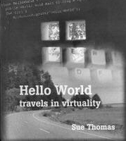December 07, 2004
Inexplicable

Walter Ong and the problem of writing about LambdaMOO
"I've known Sue Thomas online and off for about 5 years. Her contributions to understanding life online are extraordinary for three reasons. She lives fully online meaning that she immerses herself (not that she lives ONLY online). She takes time to critically and sometimes painfully reflect on her experiences. And most importantly, she shares what she has learned.
Recently she wrote an article for trAce, her online professional (and, I sense, artistic) home. In Walter Ong and the problem of writing about LambdaMOO Sue reflects on why it is so damn hard to explain online interaction experiences to those who have never had one of their own. (Bolding below is mine.)
"At trAce I often speak with people who live and work online about their perceptions of how the net has changed them and the worlds in which they move. In every conversation the transient nature of connectedness is taken so much as a given that there is hardly any need to define or describe it. Everybody knows what it is, how it feels, the energy of it, the occasional despair at its tricks and limitations. We talk about it using the common shorthand of the net - emoticons, acronyms, program code - because the language itself is the key to the concepts and experiences we are discussing. But the problem is that, despite no specific intention that this should happen, it has evolved into a secret cultural discourse which is unintelligible to the uninitiated."
Sue goes on to talk about Walter Ong's work on orality and text based literacy.
"Because Ong’s analysis convinces me that LambdaMOO and places like them are unique in that although their sole method of communication is textual, the communication that actually takes place there is oral. MOO life happens, as Ong describes of a real-life oral community, "as it really comes into being and exists, embedded in the flow of time." Its characteristics are therefore those of a group which shares physical space and human experience, and it is equally fractured and transient. Furthermore, it uses tropes and vocabulary that are also embedded within that experience and unintelligible outside it."
This set off bells for me. I recognized this shift between text created for an article or a novel, and text that "happens" from me as I participate with others online. It is oral. The back channel chat that Liz mentions is an example: how the form allowed the question to surface over the questioner. The question is the story that is passed from teller to teller in pre-literate times. For a moment, it embodies the speaker as he or she experiences typing it into the chat, but through the medium it becomes "of the group." I'm reminded of an article Stowe Boyd wrote recently about "real time," and his experience. "But more important, the idea that there is some high-order benefit in being able to collaborate asynchronously. Its always a crude approximation of real-time interaction, because the players are unavailable."
I can recount experiences for when the asynchronous has created more of a reality than real time. When the players were "available" but in a way I struggle to express. We have different experiences of what Sue called the "embedded flow of time." And for each of us, it is real.
That is what makes this whole experience almost inexplicable. It is experience rather than the reification manifest in text." Originally blogged by Nancy White.
Posted by jo at December 7, 2004 11:26 AM
